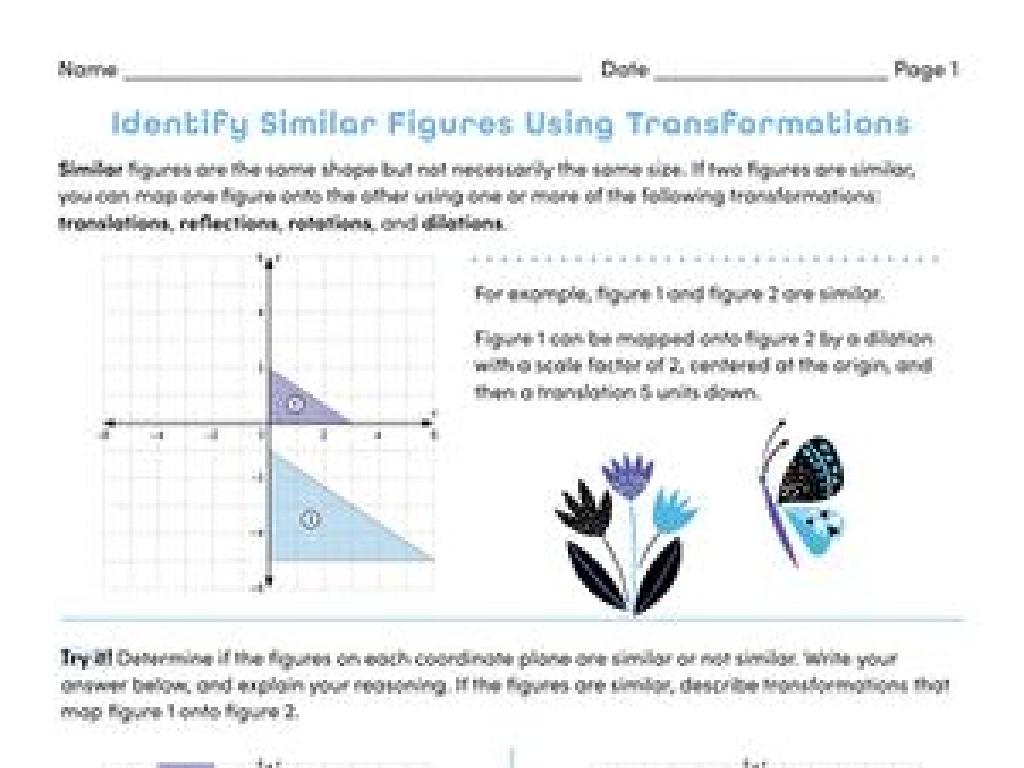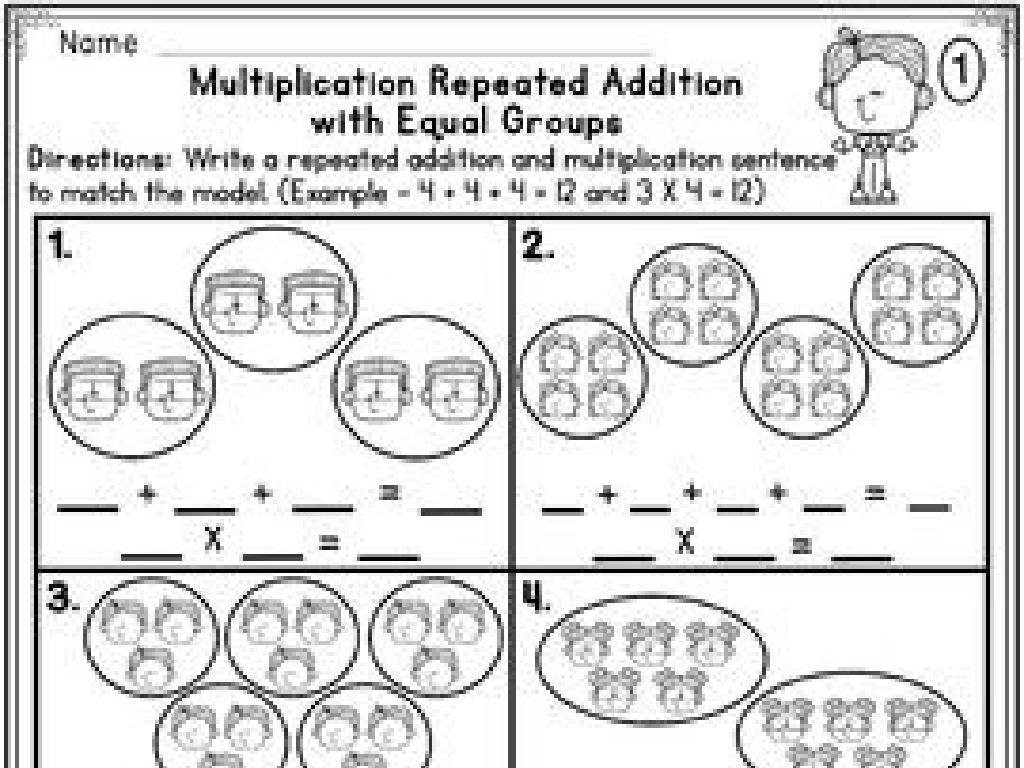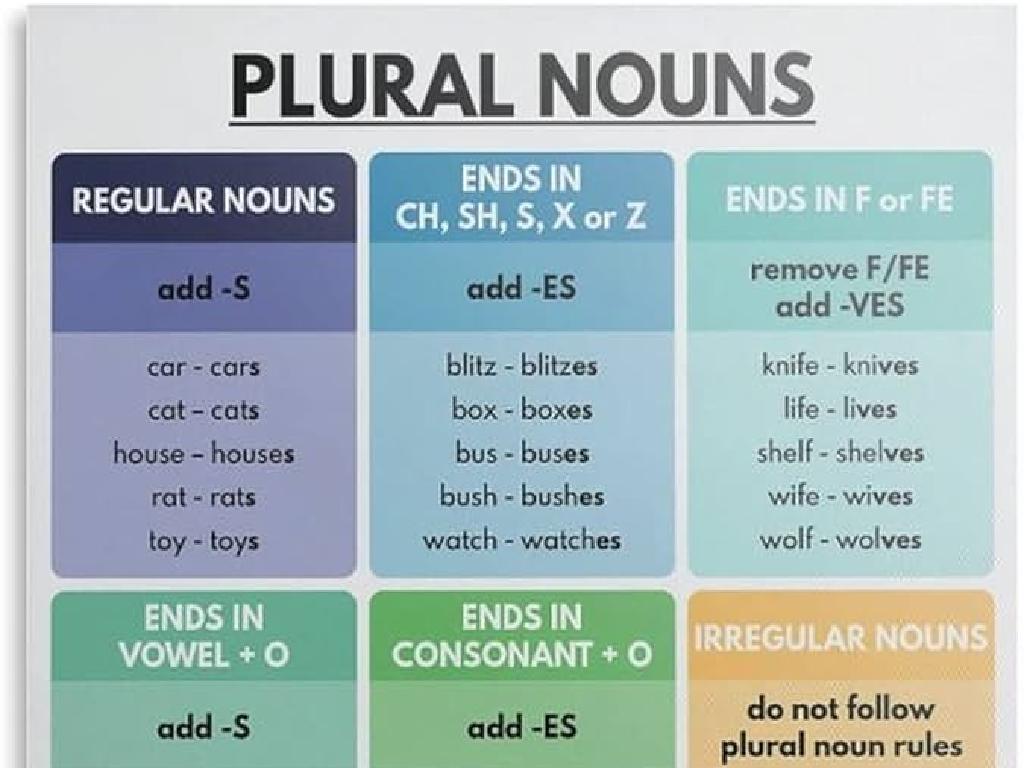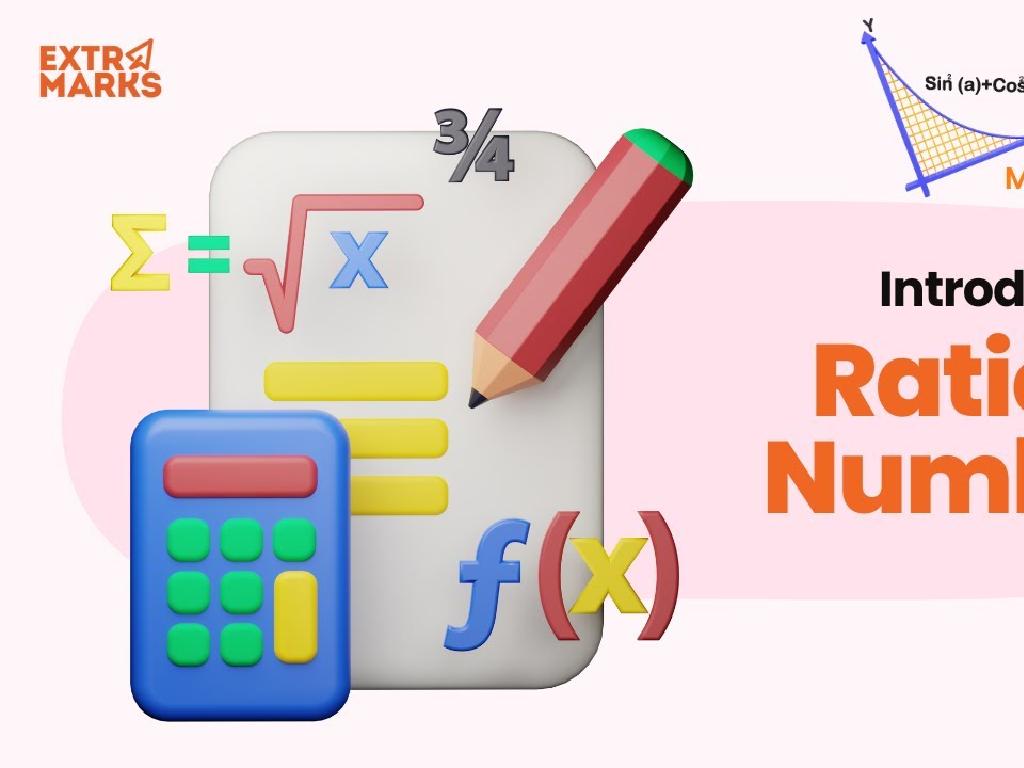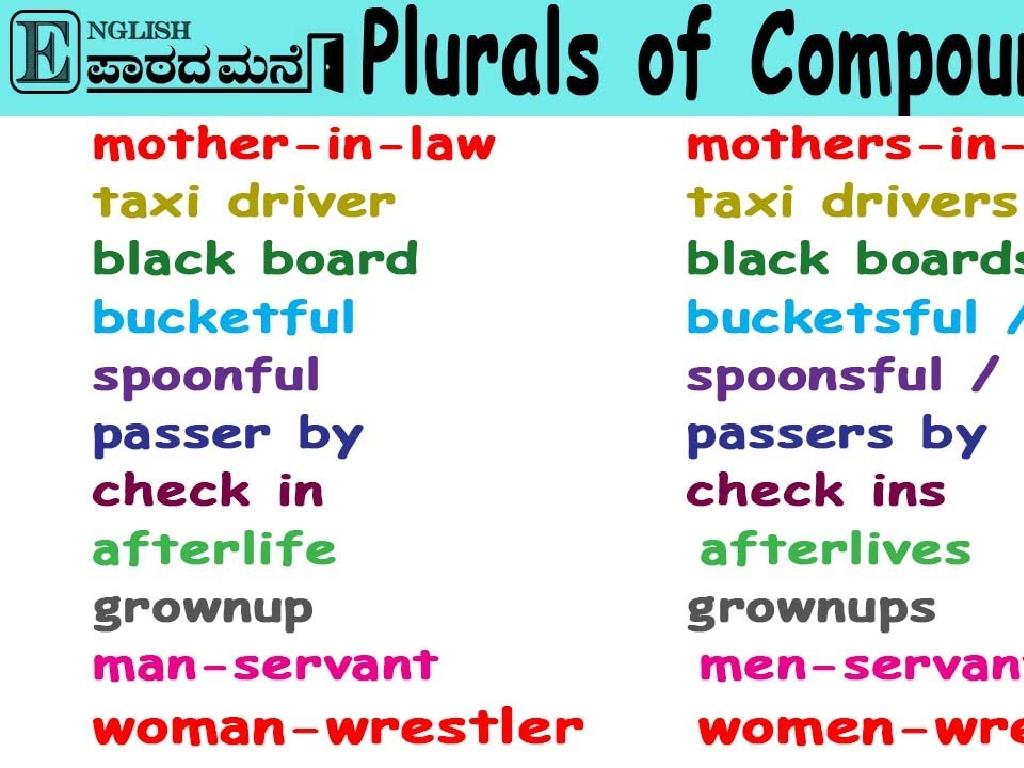Identify Halves, Thirds, And Fourths
Subject: Math
Grade: Second grade
Topic: Fractions
Please LOG IN to download the presentation. Access is available to registered users only.
View More Content
Welcome to Fractions!
– Learning about parts of a whole
– Understanding halves, thirds, and fourths
– Halves: a whole divided into 2 equal parts
– What are fractions?
– Fractions represent equal parts of a whole
– Seeing fractions in everyday life
– Examples: 1/2 a pizza, 1/3 of a cake, 1/4 of an apple
|
This slide introduces the concept of fractions to second-grade students. Begin by explaining that fractions are ways to describe equal parts of a whole object or group. Use tangible examples like cutting a pizza or a cake into halves, thirds, and fourths to illustrate the idea. Emphasize that ‘halves’ means two equal parts, ‘thirds’ means three equal parts, and ‘fourths’ means four equal parts. Show visual aids of these fractions in real-life objects to help students visualize and understand. Encourage students to think of other examples of halves, thirds, and fourths in their surroundings. This will help them relate the concept of fractions to their everyday experiences.
Understanding Fractions: What is a Whole?
– A whole is undivided
– Imagine an uncut pizza
– A pizza before slicing represents a whole
– Whole items can be split
– We can divide whole things into smaller parts
– Fractions are parts of a whole
– When we cut a whole, each piece is a fraction of it
|
This slide introduces the concept of a whole as it relates to fractions. Begin by explaining that a whole is something complete, without any divisions. Use the example of a pizza before it is cut to illustrate this concept, as it is relatable and easy for second graders to visualize. Discuss how whole items, like the pizza, can be split into smaller parts, and these parts are called fractions. Emphasize that fractions are simply portions of a whole item. This foundational understanding will set the stage for identifying specific fractions such as halves, thirds, and fourths in subsequent lessons.
Meet the Halves
– Cutting a whole into 2 equal parts
– Each part is called a half
– If you split an apple into 2 equal slices, each slice is a half.
– One half is 1 out of 2 equal parts
– Think of it as one piece of a two-piece puzzle.
– Visualizing halves with examples
– Example: One half of a sandwich, or one half of a watermelon.
|
This slide introduces the concept of halves to second-grade students. Begin by explaining that when something is cut into two equal parts, each part is called a half. Use tangible examples like cutting an apple or a sandwich to illustrate the point. Emphasize that each half is one of the two equal parts that make up the whole item. Use visual aids like pictures or actual objects to help students visualize and understand the concept of halves. Encourage students to think of other examples of halves in their daily lives and share them with the class.
Exploring Thirds in Fractions
– Cutting a whole into 3 equal parts
– Each part is called a third
– Imagine dividing a pizza into 3 slices; each slice is a third
– One third is 1 out of 3 parts
– Think of it as 1 piece of a 3-piece puzzle
– Visualizing thirds with objects
– Use items like apples or sandwiches to show thirds
|
This slide introduces the concept of thirds to second-grade students. Begin by explaining that when a whole object, like a pizza or an apple, is divided into three equal parts, each part is called a third. Emphasize that ‘third’ means one part of something that has been divided into three equal sections. Use visual aids, such as cut-out circles or real-life objects, to help students see and understand what a third looks like. Encourage students to think of other items that can be divided into thirds and to practice this concept by drawing or using manipulatives. The goal is for students to recognize and understand the fraction 1/3 as one part of a whole that is divided into three equal parts.
Understanding Fourths
– A whole cut into 4 equal parts
– Each part is a fourth or quarter
– One fourth is 1 out of 4 parts
– Visualize with pizza or pie
– Imagine cutting a pizza into 4 slices; each slice is 1/4 of the pizza.
|
This slide introduces the concept of fourths to second-grade students. Begin by explaining that when we cut something into four equal parts, each part is called a fourth or a quarter. Use visual aids like a circle or a square divided into four equal parts to illustrate this point. Emphasize that each part is exactly the same size, which is essential for understanding equal parts in fractions. To make the concept more relatable, use examples like a pizza or a pie, and show how cutting it into four equal slices results in each slice being one fourth of the whole. Encourage students to think of other examples of fourths in their daily lives and be prepared to discuss these in class.
Fractions in Everyday Life: Halves, Thirds, and Fourths
– Understanding halves through sandwiches
– When a sandwich is cut into 2 equal parts, each part is a half.
– Learning about fourths with apples
– An apple cut into 4 equal parts gives us fourths.
– Exploring thirds via pie slices
– A pie cut into 3 equal pieces shows us thirds.
– Recognizing fractions around us
|
This slide aims to help students identify and understand fractions by using relatable examples from everyday life. By visualizing a sandwich cut into two equal parts, students can grasp the concept of halves. Similarly, an apple divided into four equal sections can illustrate the idea of fourths, and a pie cut into three equal slices can demonstrate thirds. Encourage students to think of other examples from their daily experiences where they encounter halves, thirds, and fourths. This will help solidify their understanding of fractions and how they are used in real-world contexts.
Let’s Practice Fractions Together!
– Observe objects I show you
– Identify if they’re in halves, thirds, or fourths
– Is it split into 2, 3, or 4 equal parts?
– Discuss how we know the fraction
– Use clues like equal parts and number of parts
– Group activity: Fraction fun!
– We’ll work in groups to identify fractions of objects
|
This slide is for a class activity where students will practice identifying fractions with real objects. Show the students various objects that are divided into equal parts and ask them to determine whether the objects are split into halves, thirds, or fourths. Explain that halves mean two equal parts, thirds mean three equal parts, and fourths mean four equal parts. Encourage students to look for visual clues such as the number of lines or pieces an object is divided into. For the group activity, provide different objects or pictures for each group and let them work together to identify the fractions. This will help reinforce their understanding of fractions in a fun, interactive way. Be ready to assist and guide the students as they work through the activity.
Class Activity: Fraction Fun!
– Create a paper pizza
– Cut pizza into halves, thirds, or fourths
– Color each fraction differently
– Share and explain your pizza fractions
– Describe the parts of your pizza and what fraction they represent
|
This activity is designed to help students understand fractions in a fun and interactive way. Provide each student with a circle of paper that represents a pizza. Guide them to fold and cut the pizza into equal parts: halves, thirds, or fourths. Encourage creativity by allowing them to color each fraction of their pizza with different colors. Once completed, each student will present their pizza to the class, explaining the fractions they’ve created. For example, if a student cuts their pizza into fourths, they should explain that they have four equal parts and each part is one fourth of the whole pizza. This hands-on activity not only reinforces the concept of fractions but also helps students practice their speaking and explanation skills.
Review: Halves, Thirds, and Fourths
– Recap on halves, thirds, fourths
– Remember, halves split things into 2 equal parts
– Open floor for fraction questions
– It’s okay to ask questions or for examples!
– Discuss everyday fractions
– Fractions are everywhere, like in a pizza or a chocolate bar
– Engage with real-life examples
|
This slide is meant to consolidate the students’ understanding of fractions, specifically halves, thirds, and fourths. Begin by reviewing the concepts taught in the previous lessons, ensuring that the students can visualize and explain what each term means. Encourage them to ask questions to clarify any doubts. Use this opportunity to foster a discussion about where they see fractions in their daily lives, such as in dividing snacks, sharing toys, or even in time-telling with a clock. Provide examples and ask students to share their own to make the concept more relatable and to reinforce their learning. This interactive session will help assess their comprehension and will make them more comfortable with the idea of fractions.
Homework Challenge: Exploring Fractions
– Find 3 items to divide into fractions
– Draw the items split into halves, thirds, fourths
– Show each item divided equally into 2, 3, or 4 parts
– Label each fraction on your drawings
– Write ‘1/2’, ‘1/3’, ‘1/4’ on the parts to show fractions
– Share your fraction drawings next class
|
This homework assignment is designed to help students apply their understanding of fractions to real-world objects. Encourage them to find items that can be easily divided into equal parts, such as a pizza, a chocolate bar, or an apple. Remind them to draw clear lines to show the division of the item into halves, thirds, and fourths, and to label each part with the correct fraction. This will reinforce their understanding of how fractions represent parts of a whole. In the next class, have a discussion about the different items students chose and how they divided them. This will provide an opportunity for students to explain their thinking and demonstrate their grasp of the concept of fractions.

